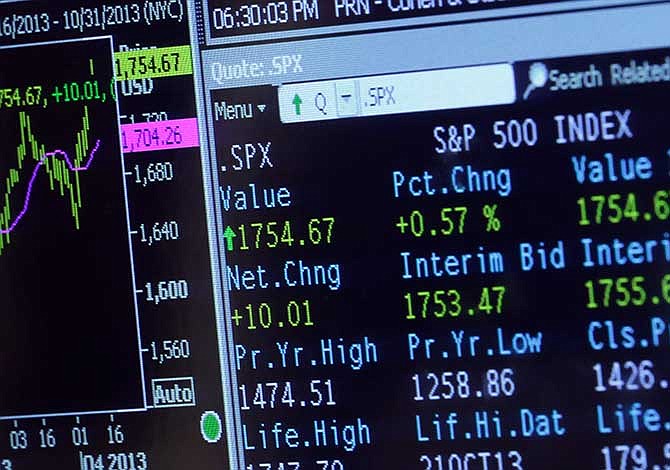NEW YORK (AP) - The stock market is poised for a "Perfect 10."
As stocks surge this year, putting them on course for their best annual performance in a decade, all ten industry groups in the Standard & Poor's 500 index are closing in on gains of 10 percent or more for 2013.
That hasn't happened in almost two decades.
The last year that all 10 industry groups in the S&P 500 closed the year higher by 10 percent or more was in 1995, when the overall index rose 31 percent. There have been several years of big yearly gains since, but none that have seen all the sectors notch double-digit jumps.
The S&P 500 gained 26 percent in 1998, but materials and energy stocks fell. The broader index advanced 26 percent in 2003 but phone companies and makers of consumer staples fell short of the 10 percent hurdle.
The reason for the broad gains this year? It's the first time since the Great Recession that investors are starting to believe that the economic recovery, while tepid, is sustainable, says Natalie Trunow, chief investment officer at Calvert Investments, an investment manager.
The housing market is recovering, hiring has picked up and people are less scared of losing their jobs. That has helped boost consumer confidence and support spending.
"Only 12 months ago, the markets were not convinced that we were in recovery mode," says Trunow, who notes there were fears the economy could slide back into recession as recently as last summer.
Here are the 10 industry groups in the S&P 500 index, which is up 26 percent so far in 2013. Here's how each sector has performed:
HEALTH CARE: Some stocks in this sector offer the prospect of explosive growth because of new drugs, or medical devices. Other, more established names like Pfizer tempt investors with attractive dividend yields. Health insurers have also done well as the Affordable Health Care Act rolls out.
This year's gain: 36 percent.
CONSUMER DISCRETIONARY: Retailers and other consumer services have surged this year, boosted by two of the stock market's star performers. Netflix has notched the biggest gain of 275 percent, driven by earnings and subscriber growth. Best Buy has jumped 230 percent as it stabilizes earnings.
This year's gain: 36 percent.
INDUSTRIALS: Delta airlines and Southwest Airlines are among the biggest gainer in this sector. Airlines tend to do well when the economy is improving as people travel more for business and leisure. Investors are also optimistic that industrial companies will benefit from an improving economy.
This year's gain: 31 percent.
FINANCIALS: Banks, insurers and other financial stocks have gained on optimism that the industry is healing after the financial crisis and the Great Recession. A recovering housing market is also helping. Genworth Financial, an insurance company, is the biggest gainer among financial stocks, surging 102 percent as its U.S. residential mortgages business recovers.
This year's gain: 30 percent.
CONSUMER STAPLES: Makers of essential, everyday products might not offer the most exciting growth prospects, but they pay a healthy dividend. Companies like Procter & Gamble are particularly attractive to investors as the yields on Treasury notes remain close to record lows.
This year's gain: 22 percent.
ENERGY: U.S. oil prices rose and U.S.-based drillers increased production dramatically, helping push domestic production to the highest level in more than two decades. This boosted the revenue and profits for some companies in the industry. Natural gas producers got a lift as prices rose from the 20-year lows they hit in 2012.
This year's gain: 20 percent.
INFORMATION TECHNOLOGY: Big things were expected from the technology industry at the start of the year. Corporations were supposed to invest in technology to boost productivity. It hasn't happened to the degree investors hoped. The sector has lagged the market. The biggest gainer in the index is chipmaker Micron, which surged 212 percent as demand for its products rose.
This year's gain: 19 percent.
MATERIALS: Sealed Air, which makes Bubble Wrap and other types of packaging, leads gains for the sector. The company's stock has risen 83 percent after returning to profitability. Owens-Illinois, a maker of glass containers for beer, liquor and other beverages, has also posted strong gains as its earnings improve.
This year's gain: 18 percent.
UTILITIES: Power companies are seen as safe and steady. They might not offer good growth prospects, but everybody needs power, and these companies pay a healthy dividend, which is important for investors seeking income.
This year's gain: 10 percent.
TELECOMMUNICATIONS: Phone companies could keep the S&P 500 from its "Perfect 10" status. They are the laggards in the index and the only group falling short of 10 percent gains. These companies are viewed in a similar light to power companies. Demand is steady, but growth prospects are limited. The compensation for investors for holding these stocks is a big dividend payment.
This year's gain: 8 percent.
AP writer Jon Fahey contributed to this report.

